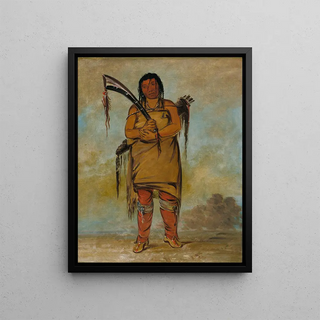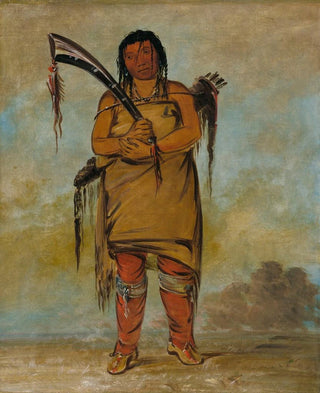Art print | WhChees un Brave - George Catlin


View from behind

Frame (optional)
In the fascinating universe of art, some works transcend the simple frame to become windows into forgotten worlds. The art print WhChees un Brave - George Catlin is a perfect illustration of this, offering a poignant glimpse into the life and traditions of Indigenous peoples of America. This piece, which evokes the strength and dignity of a Native American chief, is much more than a visual representation; it is a testament to history, an invitation to explore ancestral stories that have shaped a rich and complex culture. Through the intense gaze of the central figure, George Catlin manages to capture the very essence of Native American identity, while engaging us in a reflection on the preservation of these traditions in the face of upheavals of the era.
Style and uniqueness of the work
George Catlin's style is characterized by a blend of realism and romanticism, allowing him to pay homage to the beauty of his subjects. In "WhChees un Brave," every detail is carefully considered, from the colorful feathers adorning the chief to the symbolic patterns of his clothing, demonstrating exceptional artisanal craftsmanship. The vibrant color palette, ranging from deep reds to bright blues, creates an atmosphere that is both dynamic and serene. The artist uses light and shadow to emphasize facial features, revealing a depth of emotion that transcends time. This work stands out for its ability to evoke feelings of respect and admiration, while also prompting reflection on man's place in nature and his unbreakable connection to the world around him.
The artist and his influence
George Catlin, born in 1796, is often regarded as one of the first artists to dedicate his career to the representation of Indigenous peoples of America. Traveling across the continent, he captured fleeting moments of daily life, sacred rituals, and portraits of charismatic leaders. His work not only documented a disappearing culture but also sparked growing interest in Native American traditions within American society in the 19th century. Catlin played a crucial role in raising awareness about the

Matte finish

View from behind

Frame (optional)
In the fascinating universe of art, some works transcend the simple frame to become windows into forgotten worlds. The art print WhChees un Brave - George Catlin is a perfect illustration of this, offering a poignant glimpse into the life and traditions of Indigenous peoples of America. This piece, which evokes the strength and dignity of a Native American chief, is much more than a visual representation; it is a testament to history, an invitation to explore ancestral stories that have shaped a rich and complex culture. Through the intense gaze of the central figure, George Catlin manages to capture the very essence of Native American identity, while engaging us in a reflection on the preservation of these traditions in the face of upheavals of the era.
Style and uniqueness of the work
George Catlin's style is characterized by a blend of realism and romanticism, allowing him to pay homage to the beauty of his subjects. In "WhChees un Brave," every detail is carefully considered, from the colorful feathers adorning the chief to the symbolic patterns of his clothing, demonstrating exceptional artisanal craftsmanship. The vibrant color palette, ranging from deep reds to bright blues, creates an atmosphere that is both dynamic and serene. The artist uses light and shadow to emphasize facial features, revealing a depth of emotion that transcends time. This work stands out for its ability to evoke feelings of respect and admiration, while also prompting reflection on man's place in nature and his unbreakable connection to the world around him.
The artist and his influence
George Catlin, born in 1796, is often regarded as one of the first artists to dedicate his career to the representation of Indigenous peoples of America. Traveling across the continent, he captured fleeting moments of daily life, sacred rituals, and portraits of charismatic leaders. His work not only documented a disappearing culture but also sparked growing interest in Native American traditions within American society in the 19th century. Catlin played a crucial role in raising awareness about the






